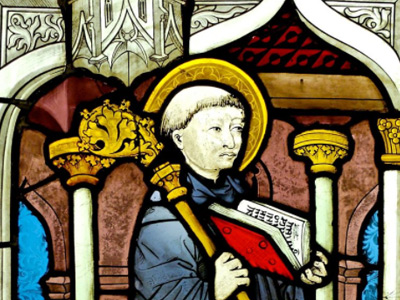Second Crusade (1147–1149)
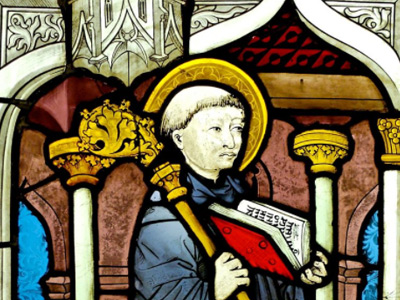
Crusade in the East
Joscelin tried to take back Edessa following Zengi's murder, but Nur ad-Din defeated him in November 1146. On 16 February 1147, the French crusaders met at Étampes to discuss their route. The Germans had already decided to travel overland through Hungary, as the sea route was politically impractical because Roger II of Sicily was an enemy of Conrad. Many of the French nobles distrusted the land route, which would take them through the Byzantine Empire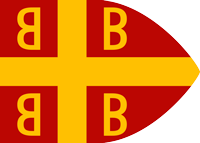 The Byzantine Empire, also referred to as the Eastern Roman Empire or Byzantium, was the continuation of the Roman Empire primarily in its eastern provinces during Late Antiquity and the Middle Ages, when its capital city was Constantinople. It survived the fragmentation and fall of the Western Roman Empire in the 5th century AD and continued to exist for an additional thousand years until the fall of Constantinople to the Ottoman Empire in 1453., the reputation of which still suffered from the accounts of the First Crusaders. Nevertheless, it was decided to follow Conrad, and to set out on 15 June. Roger II was offended and refused to participate any longer. In France
The Byzantine Empire, also referred to as the Eastern Roman Empire or Byzantium, was the continuation of the Roman Empire primarily in its eastern provinces during Late Antiquity and the Middle Ages, when its capital city was Constantinople. It survived the fragmentation and fall of the Western Roman Empire in the 5th century AD and continued to exist for an additional thousand years until the fall of Constantinople to the Ottoman Empire in 1453., the reputation of which still suffered from the accounts of the First Crusaders. Nevertheless, it was decided to follow Conrad, and to set out on 15 June. Roger II was offended and refused to participate any longer. In France The Kingdom of France is the historiographical name or umbrella term given to various political entities of France in the medieval and early modern period. It was one of the most powerful states in Europe since the High Middle Ages. It was also an early colonial power, with possessions around the world. Colonial conflicts with Great Britain led to the loss of much of its North American holdings by 1763. The Kingdom of France adopted a written constitution in 1791, but the Kingdom was abolished a year later and replaced with the First French Republic., Abbot Suger and Count William II of Nevers were elected as regents while the king would be on crusade. In Germany, further preaching was done by Adam of Ebrach, and Otto of Freising also took the cross. The Germans planned to set out at Easter, but did not leave until May.
The Kingdom of France is the historiographical name or umbrella term given to various political entities of France in the medieval and early modern period. It was one of the most powerful states in Europe since the High Middle Ages. It was also an early colonial power, with possessions around the world. Colonial conflicts with Great Britain led to the loss of much of its North American holdings by 1763. The Kingdom of France adopted a written constitution in 1791, but the Kingdom was abolished a year later and replaced with the First French Republic., Abbot Suger and Count William II of Nevers were elected as regents while the king would be on crusade. In Germany, further preaching was done by Adam of Ebrach, and Otto of Freising also took the cross. The Germans planned to set out at Easter, but did not leave until May.
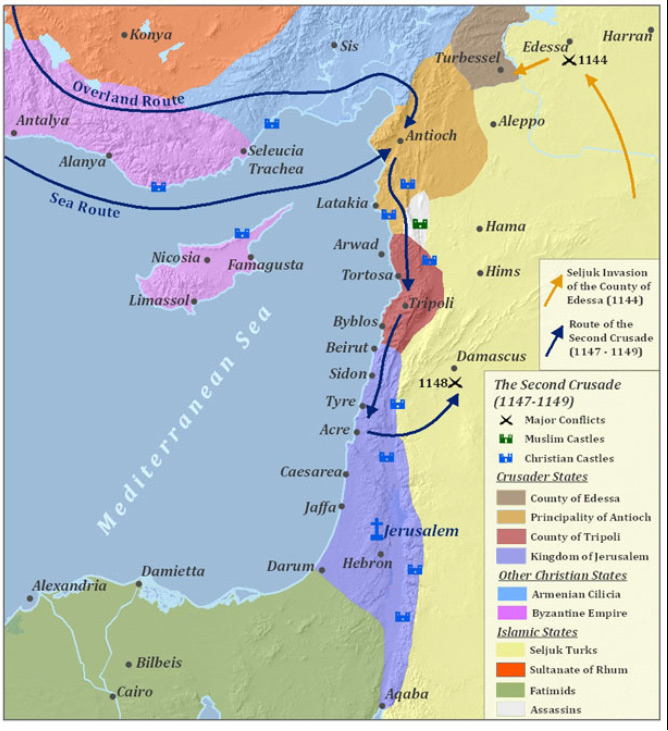
Map of the Second Crusade in the Levant
German Route
The German crusaders, accompanied by the papal legate and cardinal Theodwin, intended to meet the French in Constantinople. Ottokar III of Styria joined Conrad at Vienna, and Conrad's enemy Géza II of Hungary allowed them to pass through unharmed. When the German army of 20,000 men arrived in Byzantine territory, Emperor Manuel I Komnenos feared they were going to attack him, and Byzantine troops were posted to ensure that there was no trouble. There was a brief skirmish with some of the more unruly Germans near Philippopolis and in Adrianople, where the Byzantine general Prosouch fought with Conrad's nephew, the future emperor Frederick. To make matters worse, some of the German soldiers were killed in a flood at the beginning of September. On 10 September, however, they arrived at Constantinople, where relations with Manuel were poor, resulting in a battle, after which the Germans were convinced that they should cross into Asia Minor as quickly as possible. Manuel wanted Conrad to leave some of his troops behind, to assist in defending against attacks from Roger II, who had taken the opportunity to plunder the cities of Greece, but Conrad did not agree, despite being a fellow enemy of Roger.
In Asia Minor, Conrad decided not to wait for the French, and marched towards Iconium, capital of the Seljuq Sultanate of Rûm. Conrad split his army into two divisions. Much of the authority of the Byzantine Empire in the western provinces of Asia Minor was more nominal than real, with much of the provinces being a no-man's land controlled by Turkish nomads. Conrad underestimated the length of the march against Anatolia, and anyhow assumed that the authority of Emperor Manuel was greater in Anatolia than was in fact the case. Conrad took the knights and the best troops with himself to march overland while sending the camp followers with Otto of Freising to follow the coastal road. The king led one of these, which was almost totally destroyed by the Seljuqs on 25 October 1147 at the second battle of Dorylaeum.
In battle, the Turks used their typical tactic of pretending to retreat, and then returning to attack the small force of German cavalry which had separated from the main army to chase them. Conrad began a slow retreat back to Constantinople, and his army was harassed daily by the Turks, who attacked stragglers and defeated the rearguard. Even Conrad was wounded in a skirmish with them. The other division, led by the King's half-brother, Bishop Otto of Freising, had marched south to the Mediterranean coast and was similarly defeated early in 1148. The force led by Otto ran out of food while crossing inhospitable countryside and was ambushed by the Seljuq Turks near Laodicea on 16 November 1147. The majority of Otto's force were either killed in battle or captured and sold into slavery.
French Route
The French crusaders had departed from Metz in June 1147, led by Louis, Thierry of Alsace, Renaut I of Bar, Amadeus III, Count of Savoy and his half-brother William V of Montferrat, William VII of Auvergne, and others, along with armies from Lorraine, Brittany, Burgundy and Aquitaine. A force from Provence, led by Alphonse of Toulouse, chose to wait until August, and to cross by sea. At Worms, Louis joined with crusaders from Normandy and England The Kingdom of England was a sovereign state on the island of Great Britain from about 927, when it emerged from various Anglo-Saxon kingdoms, until 1 May 1707, when it united with Scotland to form the Kingdom of Great Britain. The Viking invasions of the 9th century upset the balance of power between the English kingdoms, and native Anglo-Saxon life in general. The English lands were unified in the 10th century in a reconquest completed by King Æthelstan in 927..
The Kingdom of England was a sovereign state on the island of Great Britain from about 927, when it emerged from various Anglo-Saxon kingdoms, until 1 May 1707, when it united with Scotland to form the Kingdom of Great Britain. The Viking invasions of the 9th century upset the balance of power between the English kingdoms, and native Anglo-Saxon life in general. The English lands were unified in the 10th century in a reconquest completed by King Æthelstan in 927..
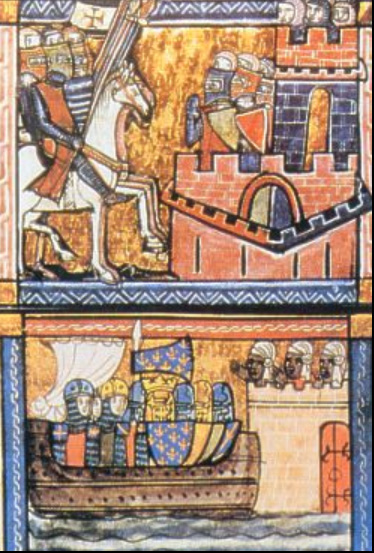
They followed Conrad's route fairly peacefully, although Louis came into conflict with king Geza of Hungary when Geza discovered Louis had allowed an attempted Hungarian usurper to join his army. Relations within Byzantine territory were also grim, and the Lorrainers, who had marched ahead of the rest of the French, also came into conflict with the slower Germans whom they met on the way.
Since the original negotiations between Louis and Manuel I, Manuel had broken off his military campaign against the Seljuk Sultanate of Rûm, signing a truce with his enemy Sultan Mesud I. This was done so that Manuel would be free to concentrate on defending his empire from the Crusaders, who had gained a reputation for theft and treachery since the First Crusade and were widely suspected of harbouring sinister designs on Constantinople. Nevertheless, Manuel's relations with the French army were somewhat better than with the Germans, and Louis was entertained lavishly in Constantinople. Some of the French were outraged by Manuel's truce with the Seljuqs and called for an alliance with Roger II and an attack on Constantinople, but they were restrained by Louis.
When the armies from Savoy, Auvergne and Montferrat joined Louis in Constantinople, having taken the land route through Italy and crossing from Brindisi to Durazzo, the entire army was shipped across the Bosporus to Asia Minor. The Greeks were encouraged by rumours that the Germans had captured Iconium (Konya), but Manuel refused to give Louis any Byzantine troops. Byzantium had just been invaded by Roger II of Sicily, and all of Manuel's army was needed in the Peloponnese. Both the Germans and French therefore entered Asia without any Byzantine assistance, unlike the armies of the First Crusade. In the tradition set by his grandfather Alexios I, Manuel also had the French swear to return to the Empire any territory they captured.
The French met the remnants of Conrad's army at Lopadion, and Conrad joined Louis' force. They followed Otto of Freising's route, moving closer to the Mediterranean coast, and they arrived at Ephesus in December, where they learned that the Turks were preparing to attack them. Manuel also sent ambassadors complaining about the pillaging and plundering that Louis had done along the way, and there was no guarantee that the Byzantines would assist them against the Turks. Meanwhile, Conrad fell sick and returned to Constantinople, where Manuel attended to him personally, and Louis, paying no attention to the warnings of a Turkish attack, marched out from Ephesus with the French and German survivors. The Turks were indeed waiting to attack, but in a small battle outside Ephesus, the French were victorious. The French fended off another Turkish ambush at the Meander River.
They reached Laodicea on the Lycus early in January 1148, around the same time Otto of Freising's army had been destroyed in the same area. Resuming the march, the vanguard under Amadeus of Savoy became separated from the rest of the army at Mount Cadmus, and Louis’ troops suffered heavy losses from the Turks. Louis himself, according to Odo of Deuil, climbed a rock and was ignored by the Turks, who did not recognize him. The Turks did not bother to attack further and the French marched on to Adalia, continually harassed from afar by the Turks, who had also burned the land to prevent the French from replenishing their food, both for themselves and their horses. Louis no longer wanted to continue by land, and it was decided to gather a fleet at Adalia and sail for Antioch. After being delayed for a month by storms, most of the promised ships did not arrive at all. Louis and his associates claimed the ships for themselves, while the rest of the army had to resume the long march to Antioch. The army was almost entirely destroyed, either by the Turks or by sickness.
Journey to Jerusalem
Louis eventually arrived in Antioch on March 19 after being delayed by storms; Amadeus of Savoy had died on Cyprus along the way. Louis was welcomed by Eleanor's uncle Raymond of Poitiers. Raymond expected him to help defend against the Turks and to accompany him on an expedition against Aleppo, the Muslim city that was the gateway to Edessa, but Louis refused, preferring instead to finish his pilgrimage to Jerusalem rather than focus on the military aspect of the crusade. Eleanor enjoyed her stay, but her uncle implored her to remain to enlarge family lands and divorce Louis if the king refused to help what was assuredly the military cause of the Crusade. During this period, there were rumours of an affair between Raymond and Eleanor, which caused tensions in the marriage between Louis and Eleanor. Louis quickly left Antioch for Tripoli with Eleanor in arrest.
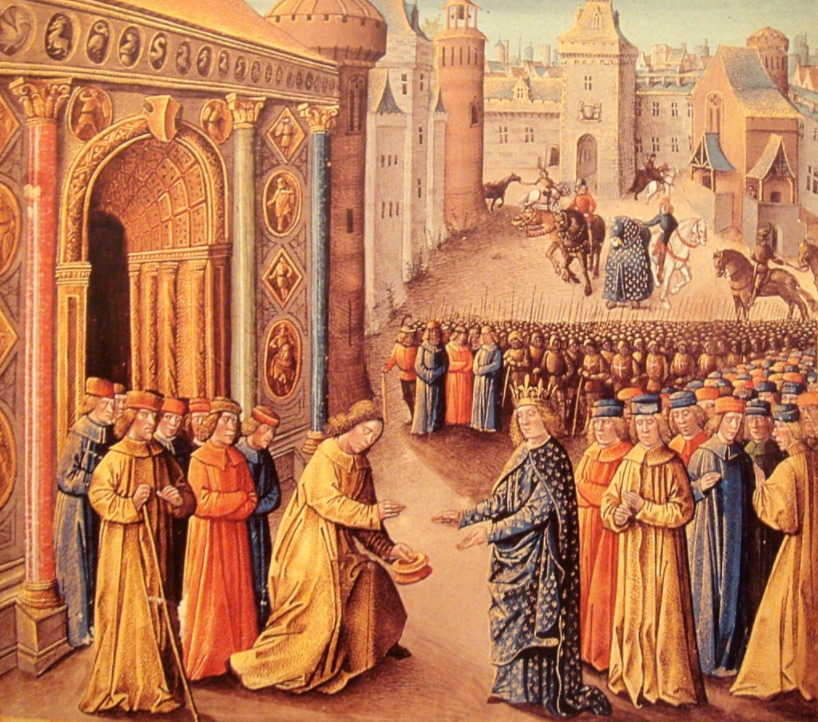
Raymond of Poitiers welcoming Louis VII in Antioch
Meanwhile, Otto of Freising and the remnant of his troops arrived in Jerusalem early in April, and Conrad soon after. Fulk, Latin Patriarch of Jerusalem, was sent to invite Louis to join them. The fleet that had stopped at Lisbon arrived around this time, as well as the Provençals who had left Europe under the command of Alfonso Jordan, Count of Toulouse. Alfonso himself did not make it to Jerusalem as he died at Caesarea. He was supposedly poisoned by Raymond II of Tripoli, the nephew who feared his political aspirations in the county. The claim that Raymond had poisoned Alfonso caused much of the Provençal force to turn back and go home. The original focus of the crusade was Edessa, but the preferred target of King Baldwin III and the Knights Templar was Damascus.
In response to the arrival of the Crusaders, the regent of Damascus, Mu'in ad-Din Unur, started making feverish preparations for war, strengthening the fortifications of Damascus, ordering troops to his city and having the water sources along the road to Damascus destroyed or diverted. Anur sought help from the Zangid rulers of Aleppo and Mosul (who were normally his rivals), though forces from these states did not arrive in time to see combat outside of Damascus. It is almost certain that the Zangid rulers delayed sending troops to Damascus out of the hope that their rival Anur might lose his city to the Crusaders.
Advertisement

These books are available for download with iBooks on your Mac or iOS device, and with iTunes on your computer. Books can be read with iBooks on your Mac or iOS device.

These books are available for download with iBooks on your Mac or iOS device, and with iTunes on your computer. Books can be read with iBooks on your Mac or iOS device.
( Click image to enlarge)
Council of Acre
The nobility of Jerusalem welcomed the arrival of troops from Europe, and it was announced that a council should meet to decide on the best target for the crusaders. This took place on 24 June 1148, when the Haute Cour of Jerusalem met with the recently arrived crusaders from Europe at Palmarea, near Acre, a major city of the crusader Kingdom of Jerusalem. This was the most spectacular meeting of the Court in its existence. "it seems well worth while and quite in harmony with the present history that the names of the nobles who were present at the council... should be recorded here for the benefit of posterity." He lists these and numerous others; "to name each one individually would take far too long."
In the end, the decision was made to attack the city of Damascus, a former ally of the Kingdom of Jerusalem that had shifted its allegiance to that of the Zengids, and attacked the Kingdom's allied city of Bosra in 1147. Historians have long seen the decision to besiege Damascus rather than Edessa as "an act of inexplicable folly". Noting the tensions between Anur, the atabeg of Damascus, and the growing power of the Zangids, many historians have argued that it would have been better for the Crusaders to focus their energy against the Zangids. More recently, historians such as David Nicolle have defended the decision to attack Damascus, arguing that Damascus was the most powerful Muslim state in southern Syria, and that if the Christians held Damascus, they would have been in a better position to resist the rising power of Nur ad-Din. Since Anur was clearly the weaker of the two Muslim rulers, it was believed that it was inevitable that Nur ad-Din would take Damascus sometime in the near future, and thus it was better for the Crusaders to hold that city rather than the Zangids. In July their armies assembled at Tiberias and marched to Damascus, around the Sea of Galilee by way of Banyas. There were perhaps 50,000 troops in total.
Siege of Damascus
The crusaders decided to attack Damascus from the west, where orchards would provide them with a constant food supply. They arrived at Daraiya on 23 July. The following day, the Muslims were prepared for the attack and constantly attacked the army advancing through the orchards outside Damascus. The defenders had sought help from Saif ad-Din Ghazi I of Mosul and Nur ad-Din of Aleppo, who personally led an attack on the crusader camp. The crusaders were pushed back from the walls into the orchards, where they were prone to ambushes and guerrilla attacks.
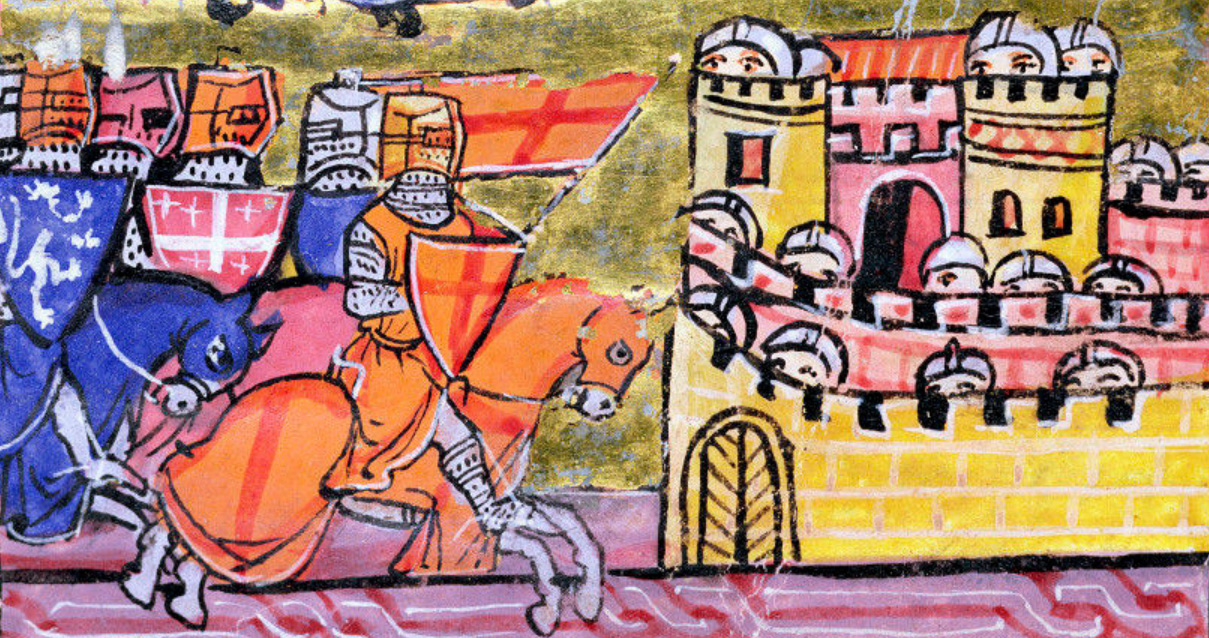
Siege of Damascus
According to William of Tyre, on 27 July the crusaders decided to move to the plain on the eastern side of the city, which was less heavily fortified but had much less food and water. It was recorded by some that Unur had bribed the leaders to move to a less defensible position, and that Unur had promised to break off his alliance with Nur ad-Din if the crusaders went home. Meanwhile, Nur ad-Din and Saif ad-Din had by now arrived. With Nur ad-Din in the field it was impossible to return to their better position. The local crusader lords refused to carry on with the siege, and the three kings had no choice but to abandon the city. First Conrad, then the rest of the army, decided to retreat to Jerusalem on 28 July, though for their entire retreat they were followed by Turkish archers who constantly harassed them.
HISTORY
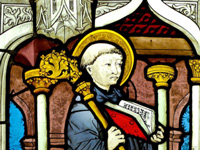
RESOURCES
This article uses material from the Wikipedia article "Second Crusade (1147–1149)", which is released under the Creative Commons Attribution-Share-Alike License 3.0.
© Stories Preschool. All Rights Reserved.
